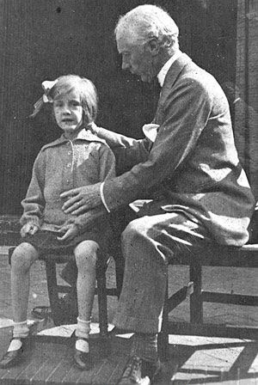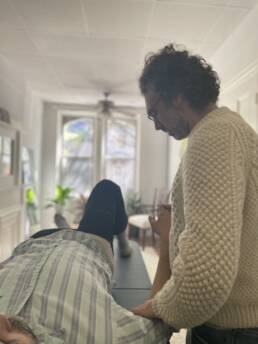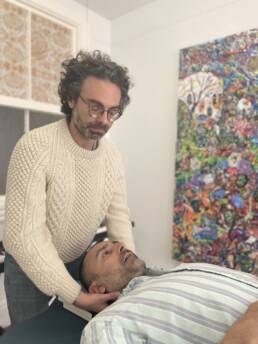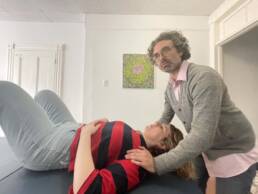
30 to 60 minute lessons that grow with you
General Lesson Outline
A classical Alexander Technique lesson is broken into 2 primary components: chair work and table work. After the student has a basic idea of how to work in the chair and on the table, we will be able to spend lesson time at other activities like playing an instrument, typing, or any specific activity that is interesting for the student.
Chair
Sitting and standing from a chair is the most common activity any of us will do in our daily active life. When you begin your chair work with me, I am looking to help you release unnecessary tension that has built up from a lifetime of habitual strain. By using my hands to guide you into and out from the chair, you will begin to regain the sensation of how your weight moves through space and how you can animate your whole self Up from the ground with only the muscular energy required to accomplish this task.
Table
Where the chair work helps you to think of yourself vertically, the table work allows you to continue the exact same type of thinking only without any need to ‘do’ something. As you lie on the table, I will use my hands to guide your head-neck, arms and legs through very basic movements. As tension releases during the table work, many people feel a wave a fatigue set in as they begin to notice just how tired they actually were. After some minutes, that fatigue resolves itself into a quiet energy; far better than any afternoon coffee. 😉
Not only do these table sessions serve as an immediate release of tension, but they serve as an example of how you should lie down on your own each day. These lie downs are the surest route to solidifying and retaining the information passed on in an Alexander Technique lesson.
Beyond Chair and Table
Many people begin their study of the Alexander Technique with a complaint of pain during an activity. This could be playing an instrument, typing, or any number of occupational or leisurely activities. Once a student has a basic idea of how to take care of themselves in sitting and standing, we can begin to look at those activities together.
For the Alexander enthusiasts, we will take a look at the 5 ‘games’ that F.M. Alexander developed to tone up his overall coordination and voice/breath work.
How many lessons will I need?
While you may of course start with one lesson and see how things go, it typically takes 20-40 lessons to have a basic grasp of the technique.
Do you know someone that teaches Alexander Technique for my instrument?
Possibly! However, my best ‘saxophone’ lessons have come from Alexander Technique teachers that have never seen a saxophone. I do my best to help you find a teacher that works for you but ultimately, YOU are the instrument.
How much are lessons?
This depends on your needs and ability to pay. Alexander Technique is not covered by insurance and my primary goal is to be there to guide you through a basic course of lessons if you enjoy the work.
Is the Alexander Technique like a Chiropractic adjustment?
No. The type of hands on work employed in the Alexander Technique is gentle and is ofter more akin to guidance.
Is the Alexander Technique like Physical Therapy?
No. Physical Therapy has its place in aiding people post surgery. I do not believe that direct strength training is useful until a student has learned how to take care of themselves at a general level.
Is the Alexander Technique Meditation?
No. However, if you choose to meditate you will find that the Alexander Technique transforms how you do this.
Ok, but what about Yoga, Pilates, Tai Chi and other modalities?
You will find that the Alexander Technique is a complete stand alone technique. Many of my students study other modalities on the side and find that Alexander Technique lessons greatly transform how they understand these other techniques. In particular, from the Alexander Technique you will learn what NOT to do and how to prevent it.




